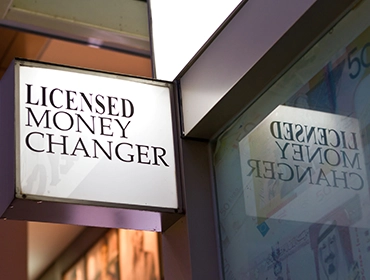 IST,
IST,


About
With the transition to a market-based system for determining the external value of the Indian rupee the foreign exchange market in India gained importance in the early reform period.
For a long time, foreign exchange in India was treated as a controlled commodity because of its limited availability. The early stages of foreign exchange management in the country focussed on control of foreign exchange by regulating the demand due to its limited supply. Exchange control was introduced in India under the Defence of India Rules on September 3, 1939 on a temporary basis. The statutory power for exchange control was provided by the Foreign Exchange Regulation Act (FERA) of 1947, which was subsequently replaced by a more comprehensive Foreign Exchange Regulation Act, 1973. This Act empowered the Reserve Bank, and in certain cases the Central Government, to control and regulate dealings in foreign exchange payments outside India, export and import of currency notes and bullion, transfer of securities between residents and non-residents, acquisition of foreign securities, and acquisition of immovable property in and outside India, among other transactions.
Extensive relaxations in the rules governing foreign exchange were initiated, prompted by the liberalisation measures introduced since 1991 and the Act was amended as a new Foreign Exchange Regulation (Amendment) Act 1993. Significant developments in the external sector, such as, substantial increase in foreign exchange reserves, growth in foreign trade, rationalisation of tariffs, current account convertibility, liberalisation of Indian investments abroad, increased access to external commercial borrowings by Indian corporates and participation of foreign institutional investors in Indian stock market, resulted in a changed environment. Keeping in view the changed environment, the Foreign Exchange Management Act (FEMA) was enacted in 1999 to replace FERA. FEMA became effective from June 1, 2000.
Key Topics

Trade and Investment
FEMA aims at facilitating external trade and payments and for promoting the orderly development and maintenance of foreign exchange markets in India.

Borrowings, Deposit Accounts and Remittances
For simplification and liberalisation of the foreign exchange facilities available to the residents, the Bank has permitted resident individuals to freely remit abroad up to liberal amount per financial year for any permissible purposes.

Licensing Money Changing
In terms of Section 10 (1) of the FEMA, 1999, the Bank, on an application, may authorise any person as an authorised person, to deal in foreign exchange as an authorised dealer, money changer or off-shore banking unit or in any other manner as it deems fit.

LO/BO/PO
In terms of FEMA, 1999, RBI makes regulations to prohibit, restrict and regulate establishment in India of a branch office or a liaison office or a project office or any other place of business by a person resident outside India.
The Reserve Bank issues licences to banks and other institutions to act as Authorised Dealers in the foreign exchange market. In keeping with the move towards liberalisation, the Reserve Bank has undertaken substantial elimination of licensing, quantitative restrictions and other regulatory and discretionary controls.
Apart from easing restrictions on foreign exchange transactions in terms of processes and procedure, the Reserve Bank has also provided the exchange facility for liberalised travel abroad for purposes, such as, conducting business, attending international conferences, undertaking technical study tours, setting up joint ventures abroad, negotiating foreign collaboration, pursuing higher studies and training, and also for medical treatment. Moreover, the Reserve Bank has permitted residents to hold liberal amount of foreign currency. Residents can now also open foreign currency accounts in India and credit specified foreign exchange receipts into it.
Foreign investment comes into India in various forms. Following the reforms path, the Reserve Bank has liberalised the provisions relating to such investments. The Reserve Bank has permitted foreign investment in almost all sectors, with a few exceptions. In many sectors, no prior approval from the Government or the Reserve Bank is required for non-residents investing in India. Foreign institutional investors are allowed to invest in all equity securities traded in the primary and secondary markets. Foreign institutional investors have also been permitted to invest in Government of India treasury bills and dated securities, corporate debt instruments and mutual funds. The NRIs have the flexibility of investing under the options of repatriation and non-repatriation.
Similarly, Indian entities can also make investment in an overseas joint venture or in a wholly-owned subsidiary abroad upto a certain limit.
Indian companies are allowed to raise external commercial borrowings including commercial-bank loans, buyers’ credit, suppliers’ credit, and securitised instruments. Foreign Currency Convertible Bonds (FCCBs) and Foreign Currency Exchangeable Bonds (FCEBs) are also governed by the ECB guidelines.
As a step towards further simplification and liberalisation of the foreign exchange facilities available to the residents, the Reserve Bank has permitted resident individuals to freely remit abroad up to liberal amount per financial year for any permissible purposes.
Exchange-traded currency futures are permitted in India. Such trading facilities are currently being offered by the National Stock Exchange, the Bombay Stock Exchange and the MCX-Stock Exchange. As the product is exchange traded, the conduct of currency futures trading facility is being regulated jointly by the Reserve Bank and the Securities and Exchange Board of India.
India’s exchange rate policy has evolved in tandem with the domestic as well as international developments. The period after independence was marked by a fixed exchange rate regime, which was in line with the Bretton Woods system prevalent then. The Indian Rupee was pegged to the Pound Sterling on account of historic links with Britain. After the breakdown of Bretton Woods System in the early seventies, most of the countries moved towards a system of flexible/managed exchange rates. With the decline in the share of Britain in India’s trade, increased diversification of India’s international transactions together with the weaknesses of pegging to a single currency, the Indian Rupee was de-linked from the Pound Sterling in September 1975.
The exchange rate subsequently came to be determined with reference to the daily exchange rate movements of an undisclosed basket of currencies of India’s major trading partners. As the basket-linked management of the exchange rate of the Rupee did not capture the market dynamics and the developments in the exchange rates of competing countries fully, the Rupee’s external value was allowed to be determined by market forces in a phased manner following the balance of payment difficulties in the nineties.
A significant two-step downward adjustment in the exchange rate of the Rupee was made in 1991. In March 1992, Liberalised Exchange Rate Management System (LERMS) involving the dual exchange rate was instituted. A unified single market-determined exchange rate system based on the demand for and supply of foreign exchange replaced the LERMS effective March 1, 1993.
The Reserve Bank’s exchange rate policy focusses on ensuring orderly conditions in the foreign exchange market. For the purpose, it closely monitors the developments in the financial markets at home and abroad. When necessary, it intervenes in the market by buying or selling foreign currencies. The market operations are undertaken either directly or through public sector banks.
In addition to the traditional instruments like forward and swap contracts, the Reserve Bank has facilitated increased availability of derivative instruments in the foreign exchange market. It has allowed trading in Rupee-foreign currency swaps, foreign currency-Rupee options, cross-currency options, interest rate swaps and currency swaps, forward rate agreements and currency futures.
The Reserve Bank of India, is the custodian of the country’s foreign exchange reserves and is vested with the responsibility of managing their investment. The legal provisions governing management of foreign exchange reserves are laid down in the Reserve Bank of India Act, 1934.
The Reserve Bank’s reserves management function has in recent years grown both in terms of importance and sophistication for two main reasons. First, the share of foreign currency assets in the balance sheet of the Reserve Bank has substantially increased. Second, with the increased volatility in exchange and interest rates in the global market, the task of preserving the value of reserves and obtaining a reasonable return on them has become challenging.
The basic parameters of the Reserve Bank’s policies for foreign exchange reserves management are safety, liquidity and returns. The Reserve Bank of India Act permits the Reserve Bank to invest the reserves in the following types of instruments:
1) Deposits with Bank for International Settlements and other central banks
2) Deposits with foreign commercial banks
3) Debt instruments representing sovereign or sovereign-guaranteed liability of not more than 10 years of residual maturity
4) Other instruments and institutions as approved by the Central Board of the Reserve Bank in accordance with the provisions of the Act
5) Certain types of derivatives
While safety and liquidity continue to be the twin-pillars of reserves management, return optimisation has become an embedded strategy within this framework. The Reserve Bank has framed policy guidelines stipulating stringent eligibility criteria for issuers, counterparties, and investments to be made with them to enhance the safety and liquidity of reserves. The Reserve Bank, in consultation with the Government, continuously reviews the reserves management strategies.
Legal Framework
పేజీ చివరిగా అప్డేట్ చేయబడిన తేదీ:











